University Nursing Care Study: Small Bowel Obstruction Management
VerifiedAdded on 2020/03/01
|41
|10656
|40
Case Study
AI Summary
This case study focuses on the nursing care of a 34-year-old female patient, Louise Wilson, admitted with a small bowel obstruction (SBO) following a previous surgery. The assignment details the patient's presentation, symptoms, and the underlying condition of SBO. It then provides a comprehensive overview of nursing models, particularly the Roper-Logan-Tierney (RLT) model, and its application in assessing, planning, implementing, and evaluating patient care. The study emphasizes the importance of nurses in identifying patient needs and providing holistic care, including assessment of activities of living, and the use of the nursing process to deliver individualized patient-focused care. It also incorporates discussions on nursing theory, nursing process, and recommendations for nursing practice in managing SBO cases, maintaining professional healthcare standards, and ensuring optimal patient outcomes. The study concludes with insights into effective nursing interventions and patient care strategies for individuals with SBO.
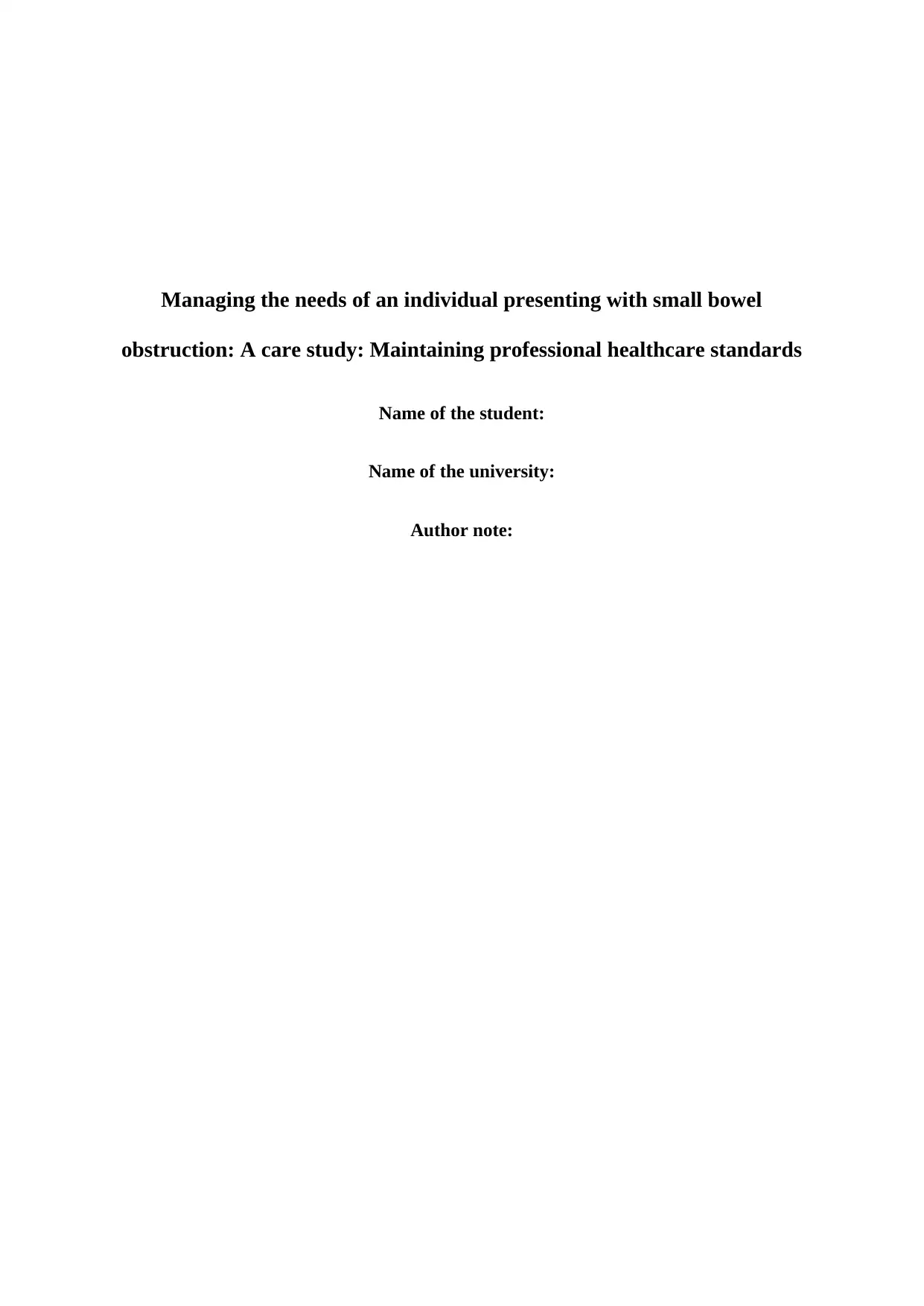
Managing the needs of an individual presenting with small bowel
obstruction: A care study: Maintaining professional healthcare standards
Name of the student:
Name of the university:
Author note:
obstruction: A care study: Maintaining professional healthcare standards
Name of the student:
Name of the university:
Author note:
Paraphrase This Document
Need a fresh take? Get an instant paraphrase of this document with our AI Paraphraser
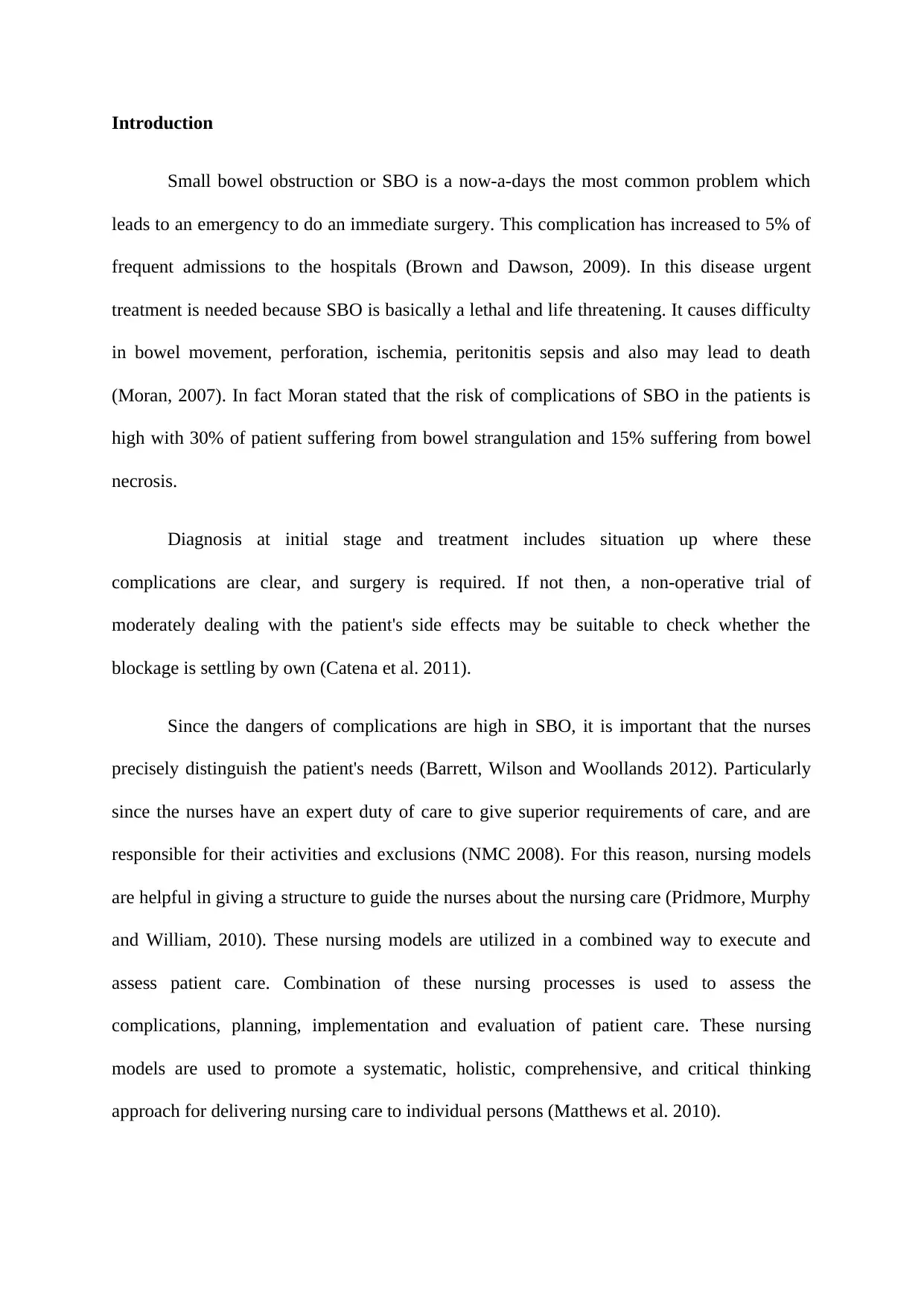
Introduction
Small bowel obstruction or SBO is a now-a-days the most common problem which
leads to an emergency to do an immediate surgery. This complication has increased to 5% of
frequent admissions to the hospitals (Brown and Dawson, 2009). In this disease urgent
treatment is needed because SBO is basically a lethal and life threatening. It causes difficulty
in bowel movement, perforation, ischemia, peritonitis sepsis and also may lead to death
(Moran, 2007). In fact Moran stated that the risk of complications of SBO in the patients is
high with 30% of patient suffering from bowel strangulation and 15% suffering from bowel
necrosis.
Diagnosis at initial stage and treatment includes situation up where these
complications are clear, and surgery is required. If not then, a non-operative trial of
moderately dealing with the patient's side effects may be suitable to check whether the
blockage is settling by own (Catena et al. 2011).
Since the dangers of complications are high in SBO, it is important that the nurses
precisely distinguish the patient's needs (Barrett, Wilson and Woollands 2012). Particularly
since the nurses have an expert duty of care to give superior requirements of care, and are
responsible for their activities and exclusions (NMC 2008). For this reason, nursing models
are helpful in giving a structure to guide the nurses about the nursing care (Pridmore, Murphy
and William, 2010). These nursing models are utilized in a combined way to execute and
assess patient care. Combination of these nursing processes is used to assess the
complications, planning, implementation and evaluation of patient care. These nursing
models are used to promote a systematic, holistic, comprehensive, and critical thinking
approach for delivering nursing care to individual persons (Matthews et al. 2010).
Small bowel obstruction or SBO is a now-a-days the most common problem which
leads to an emergency to do an immediate surgery. This complication has increased to 5% of
frequent admissions to the hospitals (Brown and Dawson, 2009). In this disease urgent
treatment is needed because SBO is basically a lethal and life threatening. It causes difficulty
in bowel movement, perforation, ischemia, peritonitis sepsis and also may lead to death
(Moran, 2007). In fact Moran stated that the risk of complications of SBO in the patients is
high with 30% of patient suffering from bowel strangulation and 15% suffering from bowel
necrosis.
Diagnosis at initial stage and treatment includes situation up where these
complications are clear, and surgery is required. If not then, a non-operative trial of
moderately dealing with the patient's side effects may be suitable to check whether the
blockage is settling by own (Catena et al. 2011).
Since the dangers of complications are high in SBO, it is important that the nurses
precisely distinguish the patient's needs (Barrett, Wilson and Woollands 2012). Particularly
since the nurses have an expert duty of care to give superior requirements of care, and are
responsible for their activities and exclusions (NMC 2008). For this reason, nursing models
are helpful in giving a structure to guide the nurses about the nursing care (Pridmore, Murphy
and William, 2010). These nursing models are utilized in a combined way to execute and
assess patient care. Combination of these nursing processes is used to assess the
complications, planning, implementation and evaluation of patient care. These nursing
models are used to promote a systematic, holistic, comprehensive, and critical thinking
approach for delivering nursing care to individual persons (Matthews et al. 2010).
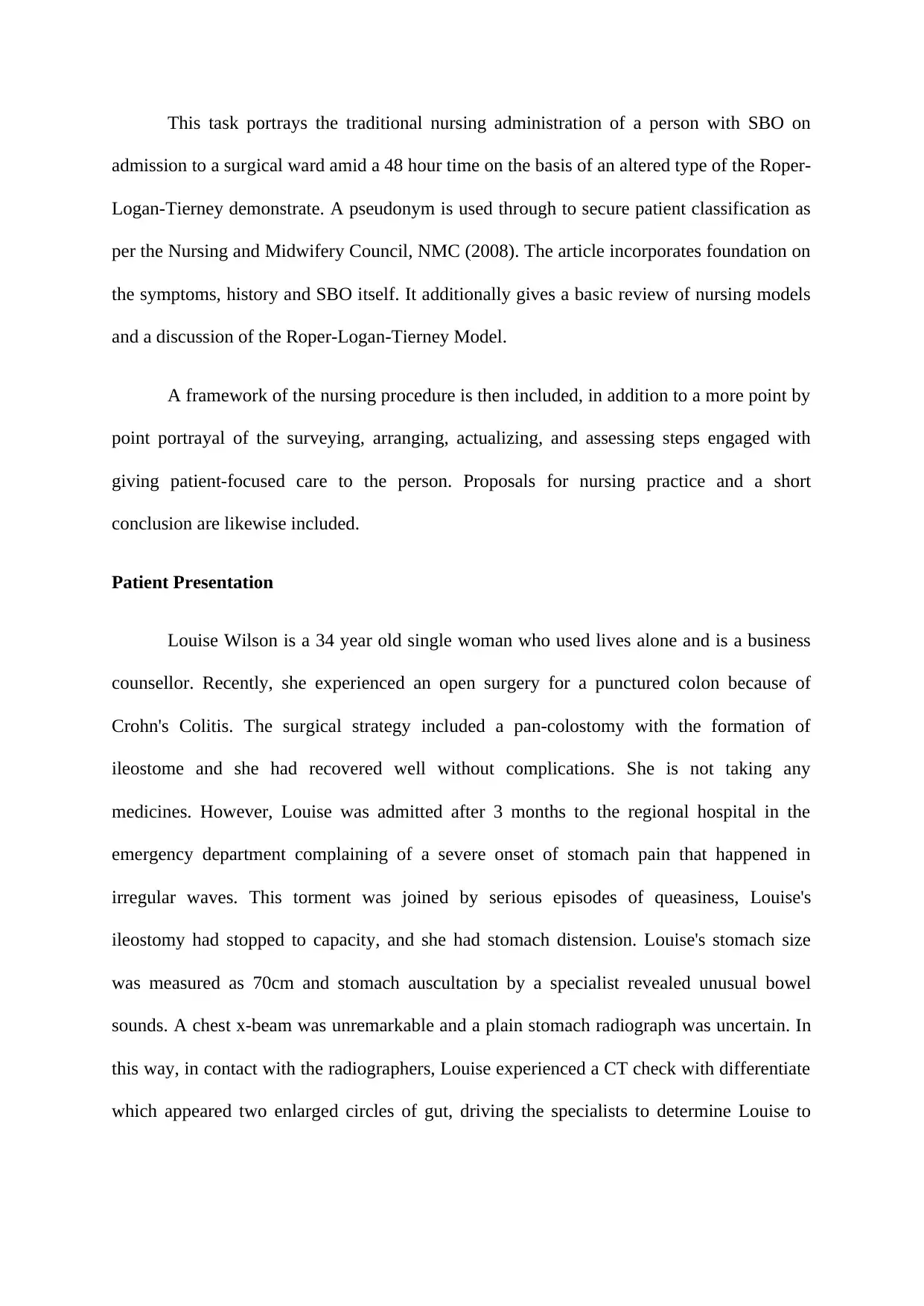
This task portrays the traditional nursing administration of a person with SBO on
admission to a surgical ward amid a 48 hour time on the basis of an altered type of the Roper-
Logan-Tierney demonstrate. A pseudonym is used through to secure patient classification as
per the Nursing and Midwifery Council, NMC (2008). The article incorporates foundation on
the symptoms, history and SBO itself. It additionally gives a basic review of nursing models
and a discussion of the Roper-Logan-Tierney Model.
A framework of the nursing procedure is then included, in addition to a more point by
point portrayal of the surveying, arranging, actualizing, and assessing steps engaged with
giving patient-focused care to the person. Proposals for nursing practice and a short
conclusion are likewise included.
Patient Presentation
Louise Wilson is a 34 year old single woman who used lives alone and is a business
counsellor. Recently, she experienced an open surgery for a punctured colon because of
Crohn's Colitis. The surgical strategy included a pan-colostomy with the formation of
ileostome and she had recovered well without complications. She is not taking any
medicines. However, Louise was admitted after 3 months to the regional hospital in the
emergency department complaining of a severe onset of stomach pain that happened in
irregular waves. This torment was joined by serious episodes of queasiness, Louise's
ileostomy had stopped to capacity, and she had stomach distension. Louise's stomach size
was measured as 70cm and stomach auscultation by a specialist revealed unusual bowel
sounds. A chest x-beam was unremarkable and a plain stomach radiograph was uncertain. In
this way, in contact with the radiographers, Louise experienced a CT check with differentiate
which appeared two enlarged circles of gut, driving the specialists to determine Louise to
admission to a surgical ward amid a 48 hour time on the basis of an altered type of the Roper-
Logan-Tierney demonstrate. A pseudonym is used through to secure patient classification as
per the Nursing and Midwifery Council, NMC (2008). The article incorporates foundation on
the symptoms, history and SBO itself. It additionally gives a basic review of nursing models
and a discussion of the Roper-Logan-Tierney Model.
A framework of the nursing procedure is then included, in addition to a more point by
point portrayal of the surveying, arranging, actualizing, and assessing steps engaged with
giving patient-focused care to the person. Proposals for nursing practice and a short
conclusion are likewise included.
Patient Presentation
Louise Wilson is a 34 year old single woman who used lives alone and is a business
counsellor. Recently, she experienced an open surgery for a punctured colon because of
Crohn's Colitis. The surgical strategy included a pan-colostomy with the formation of
ileostome and she had recovered well without complications. She is not taking any
medicines. However, Louise was admitted after 3 months to the regional hospital in the
emergency department complaining of a severe onset of stomach pain that happened in
irregular waves. This torment was joined by serious episodes of queasiness, Louise's
ileostomy had stopped to capacity, and she had stomach distension. Louise's stomach size
was measured as 70cm and stomach auscultation by a specialist revealed unusual bowel
sounds. A chest x-beam was unremarkable and a plain stomach radiograph was uncertain. In
this way, in contact with the radiographers, Louise experienced a CT check with differentiate
which appeared two enlarged circles of gut, driving the specialists to determine Louise to
⊘ This is a preview!⊘
Do you want full access?
Subscribe today to unlock all pages.

Trusted by 1+ million students worldwide
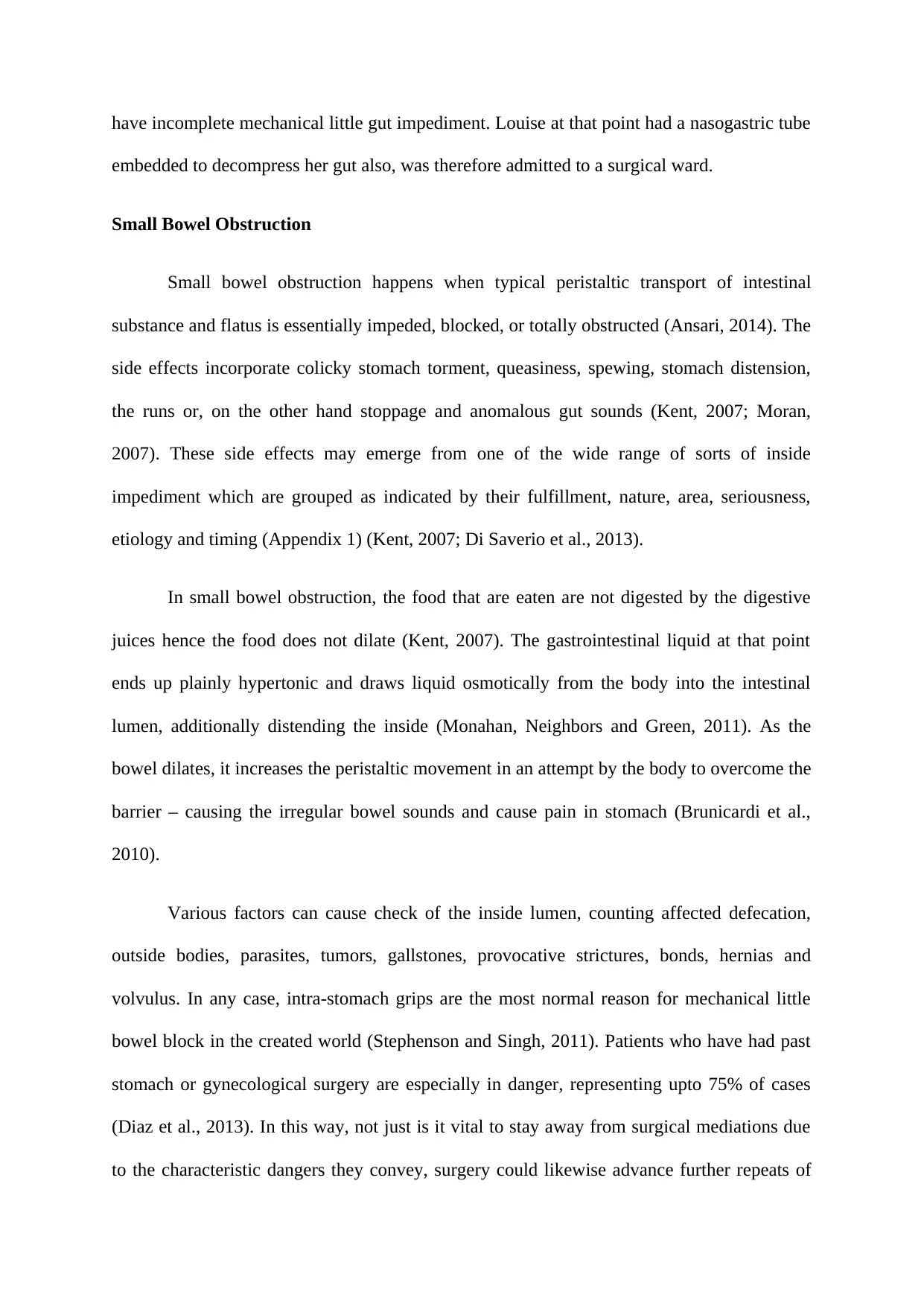
have incomplete mechanical little gut impediment. Louise at that point had a nasogastric tube
embedded to decompress her gut also, was therefore admitted to a surgical ward.
Small Bowel Obstruction
Small bowel obstruction happens when typical peristaltic transport of intestinal
substance and flatus is essentially impeded, blocked, or totally obstructed (Ansari, 2014). The
side effects incorporate colicky stomach torment, queasiness, spewing, stomach distension,
the runs or, on the other hand stoppage and anomalous gut sounds (Kent, 2007; Moran,
2007). These side effects may emerge from one of the wide range of sorts of inside
impediment which are grouped as indicated by their fulfillment, nature, area, seriousness,
etiology and timing (Appendix 1) (Kent, 2007; Di Saverio et al., 2013).
In small bowel obstruction, the food that are eaten are not digested by the digestive
juices hence the food does not dilate (Kent, 2007). The gastrointestinal liquid at that point
ends up plainly hypertonic and draws liquid osmotically from the body into the intestinal
lumen, additionally distending the inside (Monahan, Neighbors and Green, 2011). As the
bowel dilates, it increases the peristaltic movement in an attempt by the body to overcome the
barrier – causing the irregular bowel sounds and cause pain in stomach (Brunicardi et al.,
2010).
Various factors can cause check of the inside lumen, counting affected defecation,
outside bodies, parasites, tumors, gallstones, provocative strictures, bonds, hernias and
volvulus. In any case, intra-stomach grips are the most normal reason for mechanical little
bowel block in the created world (Stephenson and Singh, 2011). Patients who have had past
stomach or gynecological surgery are especially in danger, representing upto 75% of cases
(Diaz et al., 2013). In this way, not just is it vital to stay away from surgical mediations due
to the characteristic dangers they convey, surgery could likewise advance further repeats of
embedded to decompress her gut also, was therefore admitted to a surgical ward.
Small Bowel Obstruction
Small bowel obstruction happens when typical peristaltic transport of intestinal
substance and flatus is essentially impeded, blocked, or totally obstructed (Ansari, 2014). The
side effects incorporate colicky stomach torment, queasiness, spewing, stomach distension,
the runs or, on the other hand stoppage and anomalous gut sounds (Kent, 2007; Moran,
2007). These side effects may emerge from one of the wide range of sorts of inside
impediment which are grouped as indicated by their fulfillment, nature, area, seriousness,
etiology and timing (Appendix 1) (Kent, 2007; Di Saverio et al., 2013).
In small bowel obstruction, the food that are eaten are not digested by the digestive
juices hence the food does not dilate (Kent, 2007). The gastrointestinal liquid at that point
ends up plainly hypertonic and draws liquid osmotically from the body into the intestinal
lumen, additionally distending the inside (Monahan, Neighbors and Green, 2011). As the
bowel dilates, it increases the peristaltic movement in an attempt by the body to overcome the
barrier – causing the irregular bowel sounds and cause pain in stomach (Brunicardi et al.,
2010).
Various factors can cause check of the inside lumen, counting affected defecation,
outside bodies, parasites, tumors, gallstones, provocative strictures, bonds, hernias and
volvulus. In any case, intra-stomach grips are the most normal reason for mechanical little
bowel block in the created world (Stephenson and Singh, 2011). Patients who have had past
stomach or gynecological surgery are especially in danger, representing upto 75% of cases
(Diaz et al., 2013). In this way, not just is it vital to stay away from surgical mediations due
to the characteristic dangers they convey, surgery could likewise advance further repeats of
Paraphrase This Document
Need a fresh take? Get an instant paraphrase of this document with our AI Paraphraser
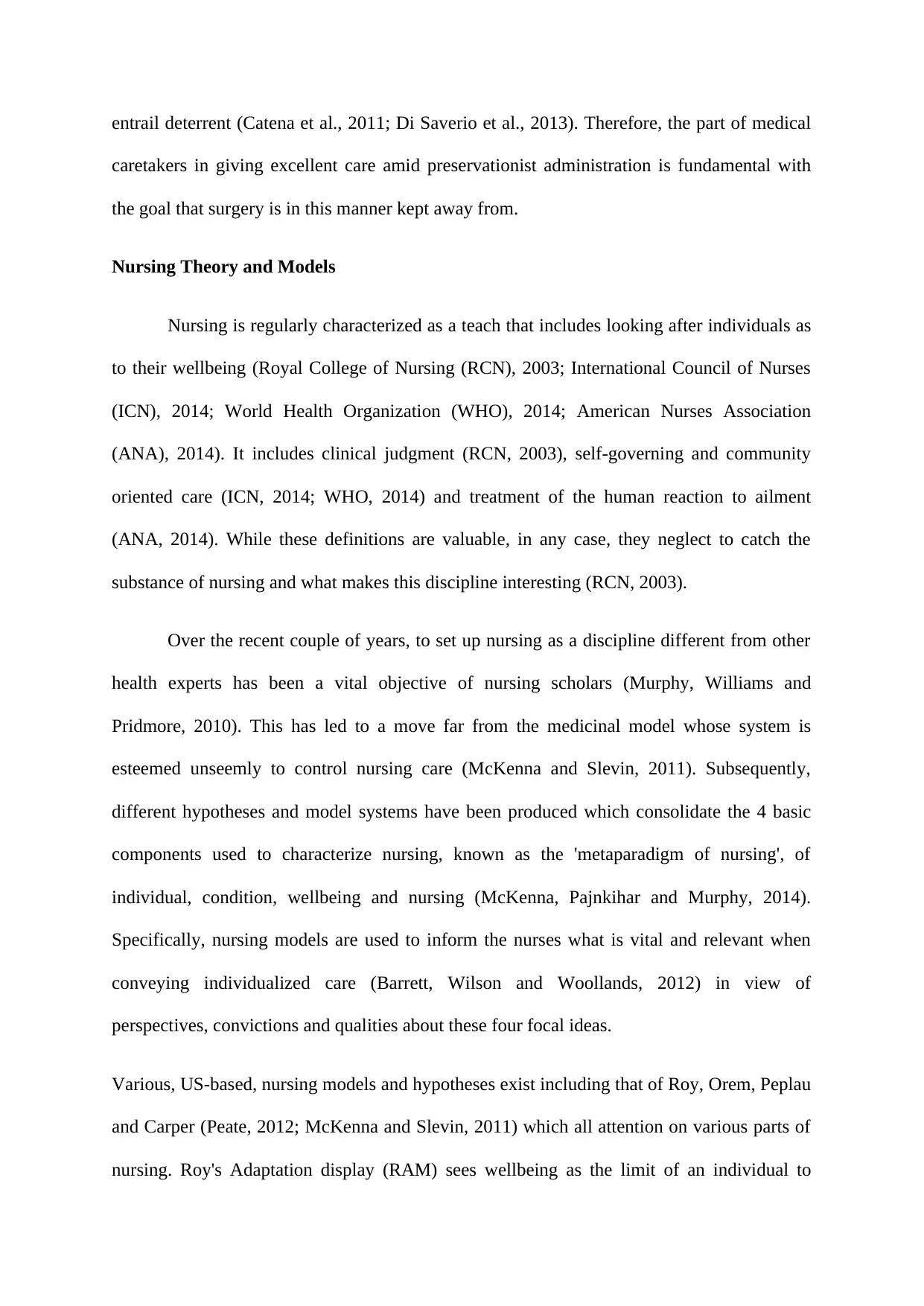
entrail deterrent (Catena et al., 2011; Di Saverio et al., 2013). Therefore, the part of medical
caretakers in giving excellent care amid preservationist administration is fundamental with
the goal that surgery is in this manner kept away from.
Nursing Theory and Models
Nursing is regularly characterized as a teach that includes looking after individuals as
to their wellbeing (Royal College of Nursing (RCN), 2003; International Council of Nurses
(ICN), 2014; World Health Organization (WHO), 2014; American Nurses Association
(ANA), 2014). It includes clinical judgment (RCN, 2003), self-governing and community
oriented care (ICN, 2014; WHO, 2014) and treatment of the human reaction to ailment
(ANA, 2014). While these definitions are valuable, in any case, they neglect to catch the
substance of nursing and what makes this discipline interesting (RCN, 2003).
Over the recent couple of years, to set up nursing as a discipline different from other
health experts has been a vital objective of nursing scholars (Murphy, Williams and
Pridmore, 2010). This has led to a move far from the medicinal model whose system is
esteemed unseemly to control nursing care (McKenna and Slevin, 2011). Subsequently,
different hypotheses and model systems have been produced which consolidate the 4 basic
components used to characterize nursing, known as the 'metaparadigm of nursing', of
individual, condition, wellbeing and nursing (McKenna, Pajnkihar and Murphy, 2014).
Specifically, nursing models are used to inform the nurses what is vital and relevant when
conveying individualized care (Barrett, Wilson and Woollands, 2012) in view of
perspectives, convictions and qualities about these four focal ideas.
Various, US-based, nursing models and hypotheses exist including that of Roy, Orem, Peplau
and Carper (Peate, 2012; McKenna and Slevin, 2011) which all attention on various parts of
nursing. Roy's Adaptation display (RAM) sees wellbeing as the limit of an individual to
caretakers in giving excellent care amid preservationist administration is fundamental with
the goal that surgery is in this manner kept away from.
Nursing Theory and Models
Nursing is regularly characterized as a teach that includes looking after individuals as
to their wellbeing (Royal College of Nursing (RCN), 2003; International Council of Nurses
(ICN), 2014; World Health Organization (WHO), 2014; American Nurses Association
(ANA), 2014). It includes clinical judgment (RCN, 2003), self-governing and community
oriented care (ICN, 2014; WHO, 2014) and treatment of the human reaction to ailment
(ANA, 2014). While these definitions are valuable, in any case, they neglect to catch the
substance of nursing and what makes this discipline interesting (RCN, 2003).
Over the recent couple of years, to set up nursing as a discipline different from other
health experts has been a vital objective of nursing scholars (Murphy, Williams and
Pridmore, 2010). This has led to a move far from the medicinal model whose system is
esteemed unseemly to control nursing care (McKenna and Slevin, 2011). Subsequently,
different hypotheses and model systems have been produced which consolidate the 4 basic
components used to characterize nursing, known as the 'metaparadigm of nursing', of
individual, condition, wellbeing and nursing (McKenna, Pajnkihar and Murphy, 2014).
Specifically, nursing models are used to inform the nurses what is vital and relevant when
conveying individualized care (Barrett, Wilson and Woollands, 2012) in view of
perspectives, convictions and qualities about these four focal ideas.
Various, US-based, nursing models and hypotheses exist including that of Roy, Orem, Peplau
and Carper (Peate, 2012; McKenna and Slevin, 2011) which all attention on various parts of
nursing. Roy's Adaptation display (RAM) sees wellbeing as the limit of an individual to
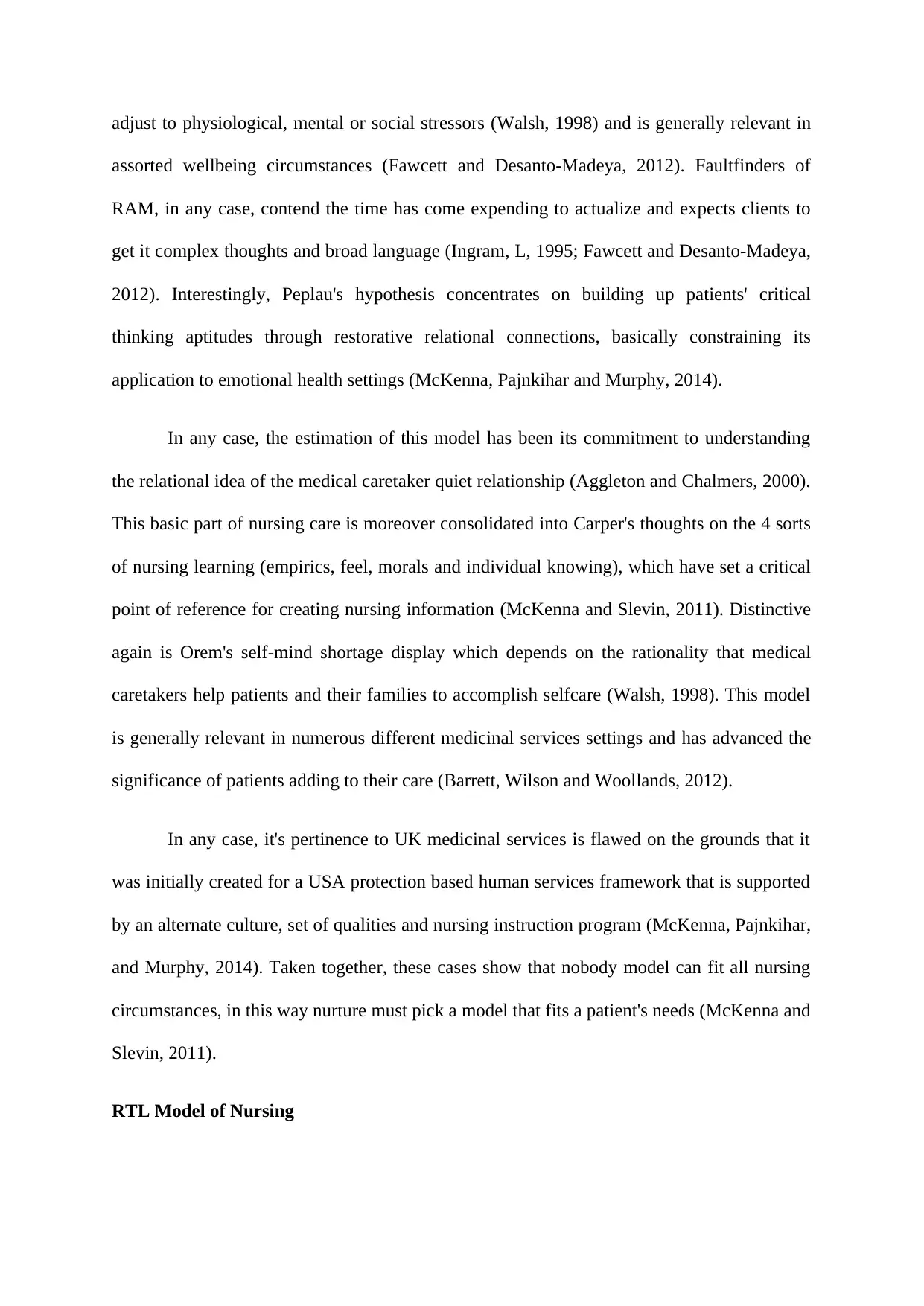
adjust to physiological, mental or social stressors (Walsh, 1998) and is generally relevant in
assorted wellbeing circumstances (Fawcett and Desanto-Madeya, 2012). Faultfinders of
RAM, in any case, contend the time has come expending to actualize and expects clients to
get it complex thoughts and broad language (Ingram, L, 1995; Fawcett and Desanto-Madeya,
2012). Interestingly, Peplau's hypothesis concentrates on building up patients' critical
thinking aptitudes through restorative relational connections, basically constraining its
application to emotional health settings (McKenna, Pajnkihar and Murphy, 2014).
In any case, the estimation of this model has been its commitment to understanding
the relational idea of the medical caretaker quiet relationship (Aggleton and Chalmers, 2000).
This basic part of nursing care is moreover consolidated into Carper's thoughts on the 4 sorts
of nursing learning (empirics, feel, morals and individual knowing), which have set a critical
point of reference for creating nursing information (McKenna and Slevin, 2011). Distinctive
again is Orem's self-mind shortage display which depends on the rationality that medical
caretakers help patients and their families to accomplish selfcare (Walsh, 1998). This model
is generally relevant in numerous different medicinal services settings and has advanced the
significance of patients adding to their care (Barrett, Wilson and Woollands, 2012).
In any case, it's pertinence to UK medicinal services is flawed on the grounds that it
was initially created for a USA protection based human services framework that is supported
by an alternate culture, set of qualities and nursing instruction program (McKenna, Pajnkihar,
and Murphy, 2014). Taken together, these cases show that nobody model can fit all nursing
circumstances, in this way nurture must pick a model that fits a patient's needs (McKenna and
Slevin, 2011).
RTL Model of Nursing
assorted wellbeing circumstances (Fawcett and Desanto-Madeya, 2012). Faultfinders of
RAM, in any case, contend the time has come expending to actualize and expects clients to
get it complex thoughts and broad language (Ingram, L, 1995; Fawcett and Desanto-Madeya,
2012). Interestingly, Peplau's hypothesis concentrates on building up patients' critical
thinking aptitudes through restorative relational connections, basically constraining its
application to emotional health settings (McKenna, Pajnkihar and Murphy, 2014).
In any case, the estimation of this model has been its commitment to understanding
the relational idea of the medical caretaker quiet relationship (Aggleton and Chalmers, 2000).
This basic part of nursing care is moreover consolidated into Carper's thoughts on the 4 sorts
of nursing learning (empirics, feel, morals and individual knowing), which have set a critical
point of reference for creating nursing information (McKenna and Slevin, 2011). Distinctive
again is Orem's self-mind shortage display which depends on the rationality that medical
caretakers help patients and their families to accomplish selfcare (Walsh, 1998). This model
is generally relevant in numerous different medicinal services settings and has advanced the
significance of patients adding to their care (Barrett, Wilson and Woollands, 2012).
In any case, it's pertinence to UK medicinal services is flawed on the grounds that it
was initially created for a USA protection based human services framework that is supported
by an alternate culture, set of qualities and nursing instruction program (McKenna, Pajnkihar,
and Murphy, 2014). Taken together, these cases show that nobody model can fit all nursing
circumstances, in this way nurture must pick a model that fits a patient's needs (McKenna and
Slevin, 2011).
RTL Model of Nursing
⊘ This is a preview!⊘
Do you want full access?
Subscribe today to unlock all pages.

Trusted by 1+ million students worldwide
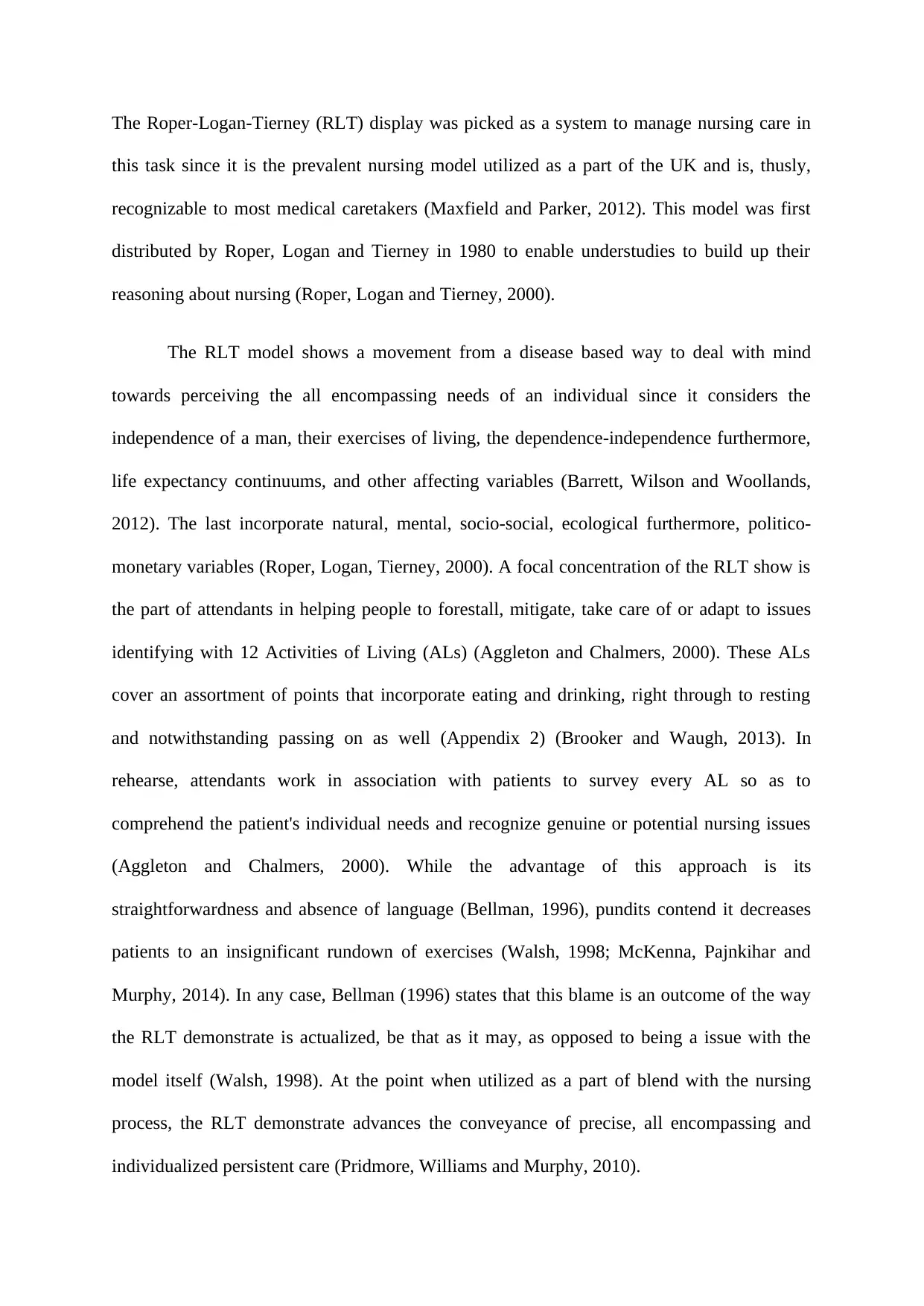
The Roper-Logan-Tierney (RLT) display was picked as a system to manage nursing care in
this task since it is the prevalent nursing model utilized as a part of the UK and is, thusly,
recognizable to most medical caretakers (Maxfield and Parker, 2012). This model was first
distributed by Roper, Logan and Tierney in 1980 to enable understudies to build up their
reasoning about nursing (Roper, Logan and Tierney, 2000).
The RLT model shows a movement from a disease based way to deal with mind
towards perceiving the all encompassing needs of an individual since it considers the
independence of a man, their exercises of living, the dependence-independence furthermore,
life expectancy continuums, and other affecting variables (Barrett, Wilson and Woollands,
2012). The last incorporate natural, mental, socio-social, ecological furthermore, politico-
monetary variables (Roper, Logan, Tierney, 2000). A focal concentration of the RLT show is
the part of attendants in helping people to forestall, mitigate, take care of or adapt to issues
identifying with 12 Activities of Living (ALs) (Aggleton and Chalmers, 2000). These ALs
cover an assortment of points that incorporate eating and drinking, right through to resting
and notwithstanding passing on as well (Appendix 2) (Brooker and Waugh, 2013). In
rehearse, attendants work in association with patients to survey every AL so as to
comprehend the patient's individual needs and recognize genuine or potential nursing issues
(Aggleton and Chalmers, 2000). While the advantage of this approach is its
straightforwardness and absence of language (Bellman, 1996), pundits contend it decreases
patients to an insignificant rundown of exercises (Walsh, 1998; McKenna, Pajnkihar and
Murphy, 2014). In any case, Bellman (1996) states that this blame is an outcome of the way
the RLT demonstrate is actualized, be that as it may, as opposed to being a issue with the
model itself (Walsh, 1998). At the point when utilized as a part of blend with the nursing
process, the RLT demonstrate advances the conveyance of precise, all encompassing and
individualized persistent care (Pridmore, Williams and Murphy, 2010).
this task since it is the prevalent nursing model utilized as a part of the UK and is, thusly,
recognizable to most medical caretakers (Maxfield and Parker, 2012). This model was first
distributed by Roper, Logan and Tierney in 1980 to enable understudies to build up their
reasoning about nursing (Roper, Logan and Tierney, 2000).
The RLT model shows a movement from a disease based way to deal with mind
towards perceiving the all encompassing needs of an individual since it considers the
independence of a man, their exercises of living, the dependence-independence furthermore,
life expectancy continuums, and other affecting variables (Barrett, Wilson and Woollands,
2012). The last incorporate natural, mental, socio-social, ecological furthermore, politico-
monetary variables (Roper, Logan, Tierney, 2000). A focal concentration of the RLT show is
the part of attendants in helping people to forestall, mitigate, take care of or adapt to issues
identifying with 12 Activities of Living (ALs) (Aggleton and Chalmers, 2000). These ALs
cover an assortment of points that incorporate eating and drinking, right through to resting
and notwithstanding passing on as well (Appendix 2) (Brooker and Waugh, 2013). In
rehearse, attendants work in association with patients to survey every AL so as to
comprehend the patient's individual needs and recognize genuine or potential nursing issues
(Aggleton and Chalmers, 2000). While the advantage of this approach is its
straightforwardness and absence of language (Bellman, 1996), pundits contend it decreases
patients to an insignificant rundown of exercises (Walsh, 1998; McKenna, Pajnkihar and
Murphy, 2014). In any case, Bellman (1996) states that this blame is an outcome of the way
the RLT demonstrate is actualized, be that as it may, as opposed to being a issue with the
model itself (Walsh, 1998). At the point when utilized as a part of blend with the nursing
process, the RLT demonstrate advances the conveyance of precise, all encompassing and
individualized persistent care (Pridmore, Williams and Murphy, 2010).
Paraphrase This Document
Need a fresh take? Get an instant paraphrase of this document with our AI Paraphraser
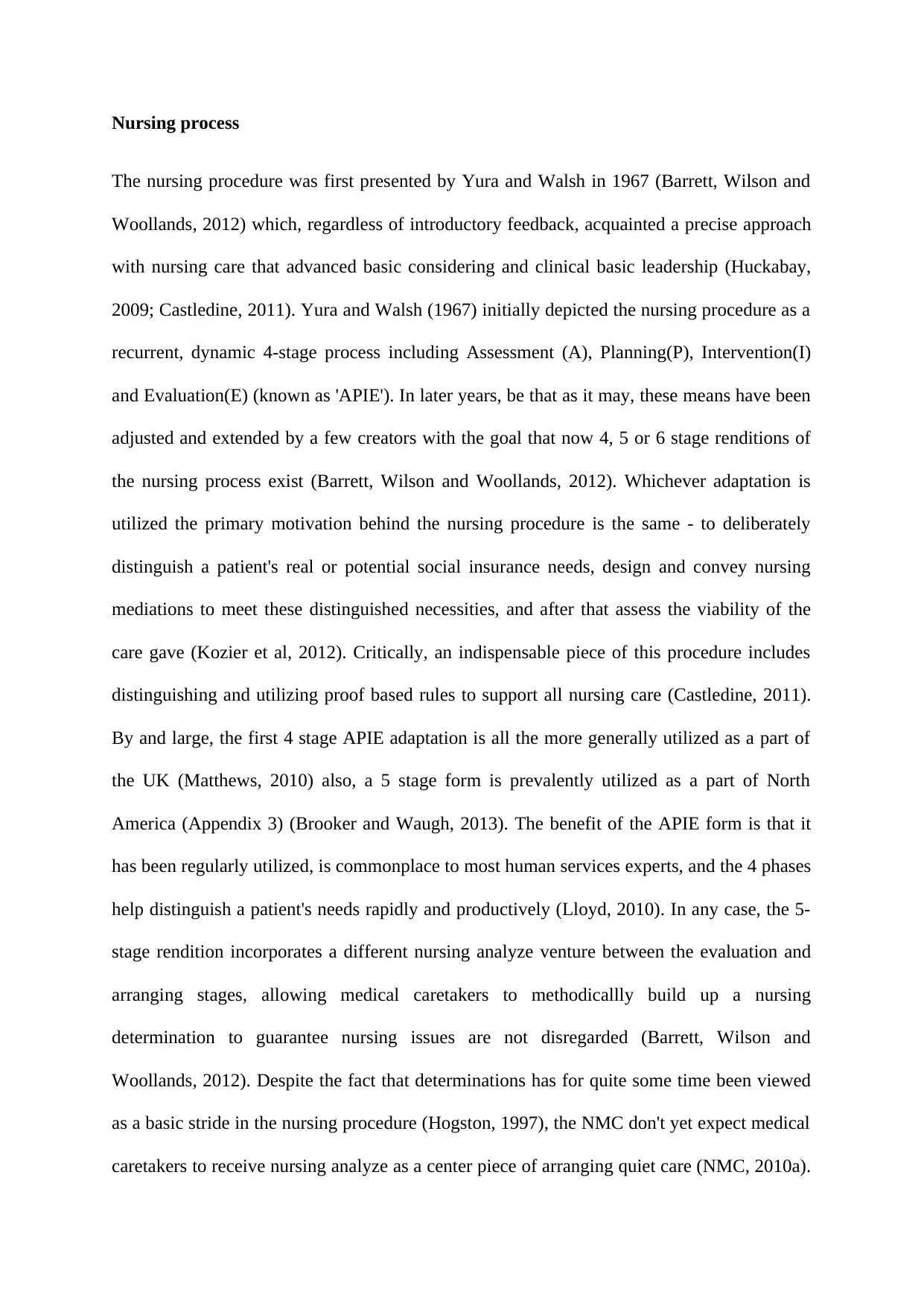
Nursing process
The nursing procedure was first presented by Yura and Walsh in 1967 (Barrett, Wilson and
Woollands, 2012) which, regardless of introductory feedback, acquainted a precise approach
with nursing care that advanced basic considering and clinical basic leadership (Huckabay,
2009; Castledine, 2011). Yura and Walsh (1967) initially depicted the nursing procedure as a
recurrent, dynamic 4-stage process including Assessment (A), Planning(P), Intervention(I)
and Evaluation(E) (known as 'APIE'). In later years, be that as it may, these means have been
adjusted and extended by a few creators with the goal that now 4, 5 or 6 stage renditions of
the nursing process exist (Barrett, Wilson and Woollands, 2012). Whichever adaptation is
utilized the primary motivation behind the nursing procedure is the same - to deliberately
distinguish a patient's real or potential social insurance needs, design and convey nursing
mediations to meet these distinguished necessities, and after that assess the viability of the
care gave (Kozier et al, 2012). Critically, an indispensable piece of this procedure includes
distinguishing and utilizing proof based rules to support all nursing care (Castledine, 2011).
By and large, the first 4 stage APIE adaptation is all the more generally utilized as a part of
the UK (Matthews, 2010) also, a 5 stage form is prevalently utilized as a part of North
America (Appendix 3) (Brooker and Waugh, 2013). The benefit of the APIE form is that it
has been regularly utilized, is commonplace to most human services experts, and the 4 phases
help distinguish a patient's needs rapidly and productively (Lloyd, 2010). In any case, the 5-
stage rendition incorporates a different nursing analyze venture between the evaluation and
arranging stages, allowing medical caretakers to methodicallly build up a nursing
determination to guarantee nursing issues are not disregarded (Barrett, Wilson and
Woollands, 2012). Despite the fact that determinations has for quite some time been viewed
as a basic stride in the nursing procedure (Hogston, 1997), the NMC don't yet expect medical
caretakers to receive nursing analyze as a center piece of arranging quiet care (NMC, 2010a).
The nursing procedure was first presented by Yura and Walsh in 1967 (Barrett, Wilson and
Woollands, 2012) which, regardless of introductory feedback, acquainted a precise approach
with nursing care that advanced basic considering and clinical basic leadership (Huckabay,
2009; Castledine, 2011). Yura and Walsh (1967) initially depicted the nursing procedure as a
recurrent, dynamic 4-stage process including Assessment (A), Planning(P), Intervention(I)
and Evaluation(E) (known as 'APIE'). In later years, be that as it may, these means have been
adjusted and extended by a few creators with the goal that now 4, 5 or 6 stage renditions of
the nursing process exist (Barrett, Wilson and Woollands, 2012). Whichever adaptation is
utilized the primary motivation behind the nursing procedure is the same - to deliberately
distinguish a patient's real or potential social insurance needs, design and convey nursing
mediations to meet these distinguished necessities, and after that assess the viability of the
care gave (Kozier et al, 2012). Critically, an indispensable piece of this procedure includes
distinguishing and utilizing proof based rules to support all nursing care (Castledine, 2011).
By and large, the first 4 stage APIE adaptation is all the more generally utilized as a part of
the UK (Matthews, 2010) also, a 5 stage form is prevalently utilized as a part of North
America (Appendix 3) (Brooker and Waugh, 2013). The benefit of the APIE form is that it
has been regularly utilized, is commonplace to most human services experts, and the 4 phases
help distinguish a patient's needs rapidly and productively (Lloyd, 2010). In any case, the 5-
stage rendition incorporates a different nursing analyze venture between the evaluation and
arranging stages, allowing medical caretakers to methodicallly build up a nursing
determination to guarantee nursing issues are not disregarded (Barrett, Wilson and
Woollands, 2012). Despite the fact that determinations has for quite some time been viewed
as a basic stride in the nursing procedure (Hogston, 1997), the NMC don't yet expect medical
caretakers to receive nursing analyze as a center piece of arranging quiet care (NMC, 2010a).
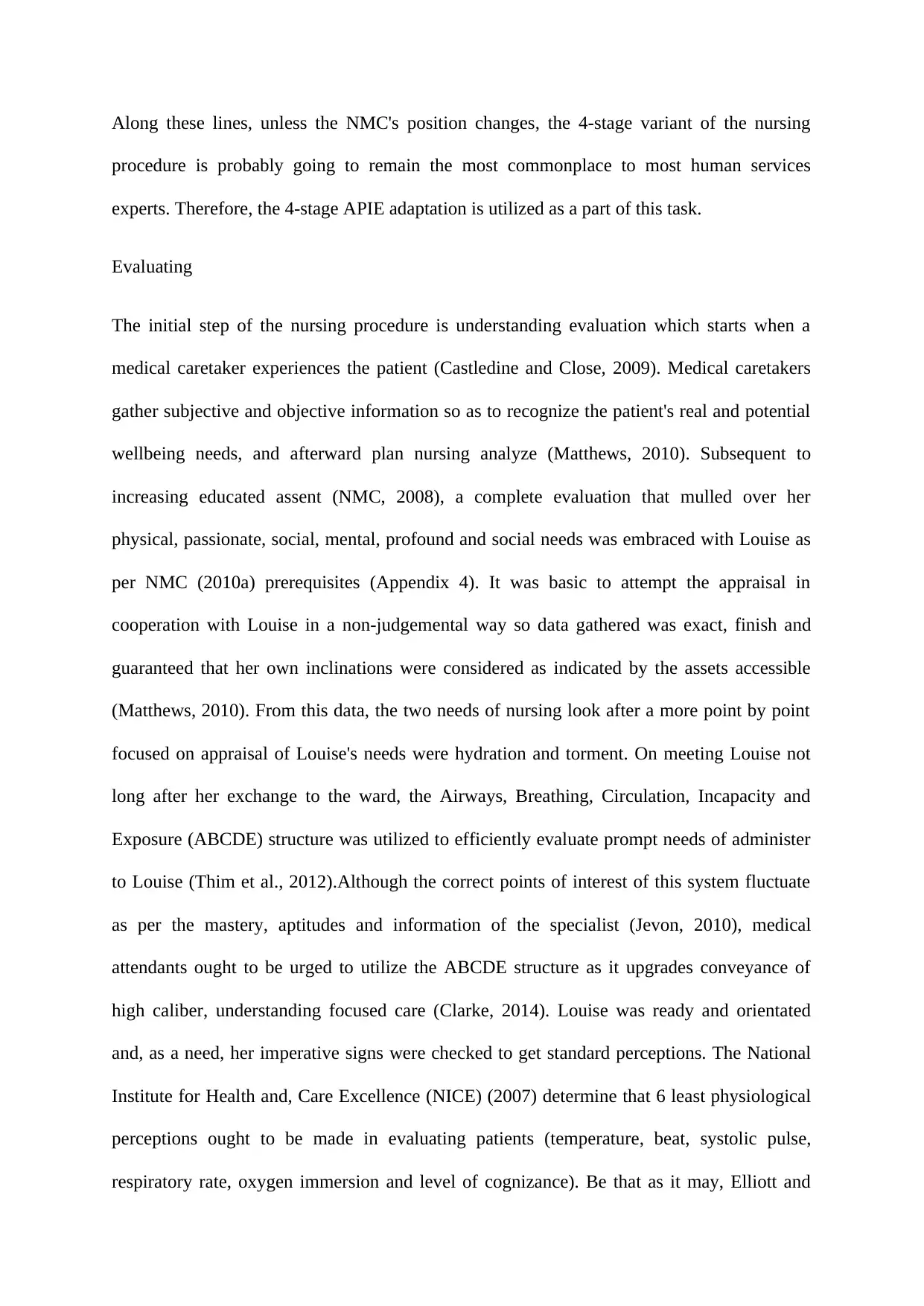
Along these lines, unless the NMC's position changes, the 4-stage variant of the nursing
procedure is probably going to remain the most commonplace to most human services
experts. Therefore, the 4-stage APIE adaptation is utilized as a part of this task.
Evaluating
The initial step of the nursing procedure is understanding evaluation which starts when a
medical caretaker experiences the patient (Castledine and Close, 2009). Medical caretakers
gather subjective and objective information so as to recognize the patient's real and potential
wellbeing needs, and afterward plan nursing analyze (Matthews, 2010). Subsequent to
increasing educated assent (NMC, 2008), a complete evaluation that mulled over her
physical, passionate, social, mental, profound and social needs was embraced with Louise as
per NMC (2010a) prerequisites (Appendix 4). It was basic to attempt the appraisal in
cooperation with Louise in a non-judgemental way so data gathered was exact, finish and
guaranteed that her own inclinations were considered as indicated by the assets accessible
(Matthews, 2010). From this data, the two needs of nursing look after a more point by point
focused on appraisal of Louise's needs were hydration and torment. On meeting Louise not
long after her exchange to the ward, the Airways, Breathing, Circulation, Incapacity and
Exposure (ABCDE) structure was utilized to efficiently evaluate prompt needs of administer
to Louise (Thim et al., 2012).Although the correct points of interest of this system fluctuate
as per the mastery, aptitudes and information of the specialist (Jevon, 2010), medical
attendants ought to be urged to utilize the ABCDE structure as it upgrades conveyance of
high caliber, understanding focused care (Clarke, 2014). Louise was ready and orientated
and, as a need, her imperative signs were checked to get standard perceptions. The National
Institute for Health and, Care Excellence (NICE) (2007) determine that 6 least physiological
perceptions ought to be made in evaluating patients (temperature, beat, systolic pulse,
respiratory rate, oxygen immersion and level of cognizance). Be that as it may, Elliott and
procedure is probably going to remain the most commonplace to most human services
experts. Therefore, the 4-stage APIE adaptation is utilized as a part of this task.
Evaluating
The initial step of the nursing procedure is understanding evaluation which starts when a
medical caretaker experiences the patient (Castledine and Close, 2009). Medical caretakers
gather subjective and objective information so as to recognize the patient's real and potential
wellbeing needs, and afterward plan nursing analyze (Matthews, 2010). Subsequent to
increasing educated assent (NMC, 2008), a complete evaluation that mulled over her
physical, passionate, social, mental, profound and social needs was embraced with Louise as
per NMC (2010a) prerequisites (Appendix 4). It was basic to attempt the appraisal in
cooperation with Louise in a non-judgemental way so data gathered was exact, finish and
guaranteed that her own inclinations were considered as indicated by the assets accessible
(Matthews, 2010). From this data, the two needs of nursing look after a more point by point
focused on appraisal of Louise's needs were hydration and torment. On meeting Louise not
long after her exchange to the ward, the Airways, Breathing, Circulation, Incapacity and
Exposure (ABCDE) structure was utilized to efficiently evaluate prompt needs of administer
to Louise (Thim et al., 2012).Although the correct points of interest of this system fluctuate
as per the mastery, aptitudes and information of the specialist (Jevon, 2010), medical
attendants ought to be urged to utilize the ABCDE structure as it upgrades conveyance of
high caliber, understanding focused care (Clarke, 2014). Louise was ready and orientated
and, as a need, her imperative signs were checked to get standard perceptions. The National
Institute for Health and, Care Excellence (NICE) (2007) determine that 6 least physiological
perceptions ought to be made in evaluating patients (temperature, beat, systolic pulse,
respiratory rate, oxygen immersion and level of cognizance). Be that as it may, Elliott and
⊘ This is a preview!⊘
Do you want full access?
Subscribe today to unlock all pages.

Trusted by 1+ million students worldwide
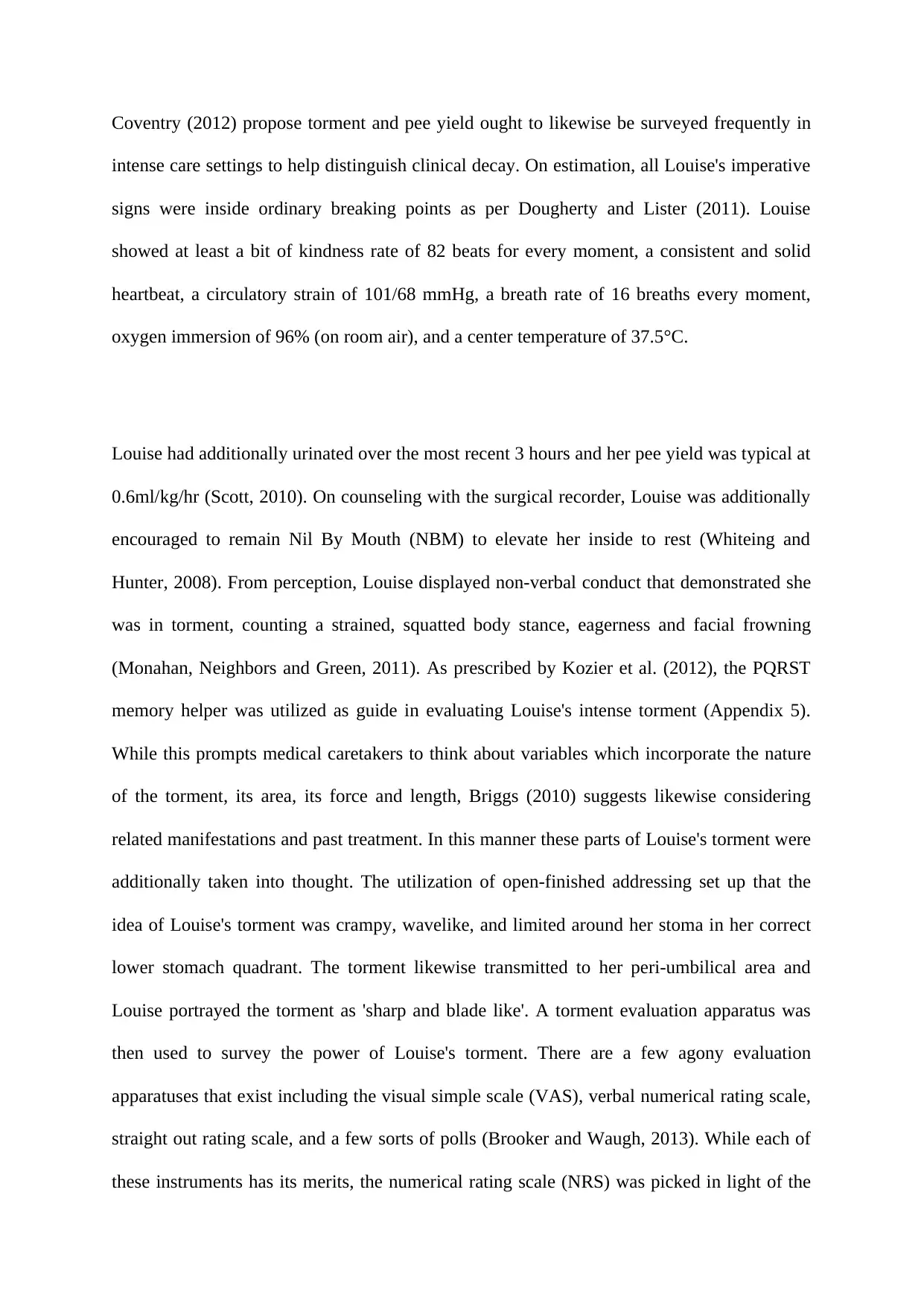
Coventry (2012) propose torment and pee yield ought to likewise be surveyed frequently in
intense care settings to help distinguish clinical decay. On estimation, all Louise's imperative
signs were inside ordinary breaking points as per Dougherty and Lister (2011). Louise
showed at least a bit of kindness rate of 82 beats for every moment, a consistent and solid
heartbeat, a circulatory strain of 101/68 mmHg, a breath rate of 16 breaths every moment,
oxygen immersion of 96% (on room air), and a center temperature of 37.5°C.
Louise had additionally urinated over the most recent 3 hours and her pee yield was typical at
0.6ml/kg/hr (Scott, 2010). On counseling with the surgical recorder, Louise was additionally
encouraged to remain Nil By Mouth (NBM) to elevate her inside to rest (Whiteing and
Hunter, 2008). From perception, Louise displayed non-verbal conduct that demonstrated she
was in torment, counting a strained, squatted body stance, eagerness and facial frowning
(Monahan, Neighbors and Green, 2011). As prescribed by Kozier et al. (2012), the PQRST
memory helper was utilized as guide in evaluating Louise's intense torment (Appendix 5).
While this prompts medical caretakers to think about variables which incorporate the nature
of the torment, its area, its force and length, Briggs (2010) suggests likewise considering
related manifestations and past treatment. In this manner these parts of Louise's torment were
additionally taken into thought. The utilization of open-finished addressing set up that the
idea of Louise's torment was crampy, wavelike, and limited around her stoma in her correct
lower stomach quadrant. The torment likewise transmitted to her peri-umbilical area and
Louise portrayed the torment as 'sharp and blade like'. A torment evaluation apparatus was
then used to survey the power of Louise's torment. There are a few agony evaluation
apparatuses that exist including the visual simple scale (VAS), verbal numerical rating scale,
straight out rating scale, and a few sorts of polls (Brooker and Waugh, 2013). While each of
these instruments has its merits, the numerical rating scale (NRS) was picked in light of the
intense care settings to help distinguish clinical decay. On estimation, all Louise's imperative
signs were inside ordinary breaking points as per Dougherty and Lister (2011). Louise
showed at least a bit of kindness rate of 82 beats for every moment, a consistent and solid
heartbeat, a circulatory strain of 101/68 mmHg, a breath rate of 16 breaths every moment,
oxygen immersion of 96% (on room air), and a center temperature of 37.5°C.
Louise had additionally urinated over the most recent 3 hours and her pee yield was typical at
0.6ml/kg/hr (Scott, 2010). On counseling with the surgical recorder, Louise was additionally
encouraged to remain Nil By Mouth (NBM) to elevate her inside to rest (Whiteing and
Hunter, 2008). From perception, Louise displayed non-verbal conduct that demonstrated she
was in torment, counting a strained, squatted body stance, eagerness and facial frowning
(Monahan, Neighbors and Green, 2011). As prescribed by Kozier et al. (2012), the PQRST
memory helper was utilized as guide in evaluating Louise's intense torment (Appendix 5).
While this prompts medical caretakers to think about variables which incorporate the nature
of the torment, its area, its force and length, Briggs (2010) suggests likewise considering
related manifestations and past treatment. In this manner these parts of Louise's torment were
additionally taken into thought. The utilization of open-finished addressing set up that the
idea of Louise's torment was crampy, wavelike, and limited around her stoma in her correct
lower stomach quadrant. The torment likewise transmitted to her peri-umbilical area and
Louise portrayed the torment as 'sharp and blade like'. A torment evaluation apparatus was
then used to survey the power of Louise's torment. There are a few agony evaluation
apparatuses that exist including the visual simple scale (VAS), verbal numerical rating scale,
straight out rating scale, and a few sorts of polls (Brooker and Waugh, 2013). While each of
these instruments has its merits, the numerical rating scale (NRS) was picked in light of the
Paraphrase This Document
Need a fresh take? Get an instant paraphrase of this document with our AI Paraphraser
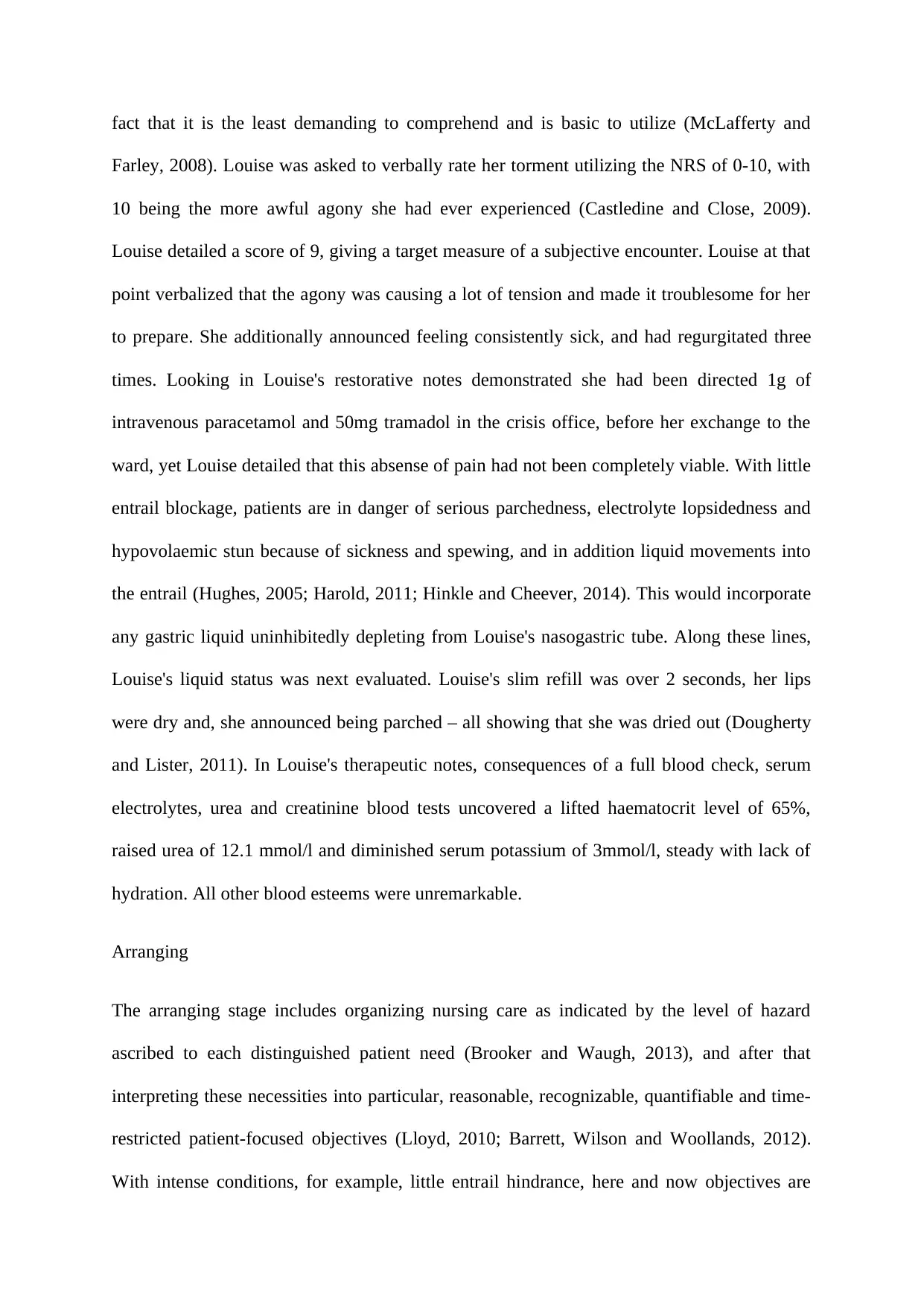
fact that it is the least demanding to comprehend and is basic to utilize (McLafferty and
Farley, 2008). Louise was asked to verbally rate her torment utilizing the NRS of 0-10, with
10 being the more awful agony she had ever experienced (Castledine and Close, 2009).
Louise detailed a score of 9, giving a target measure of a subjective encounter. Louise at that
point verbalized that the agony was causing a lot of tension and made it troublesome for her
to prepare. She additionally announced feeling consistently sick, and had regurgitated three
times. Looking in Louise's restorative notes demonstrated she had been directed 1g of
intravenous paracetamol and 50mg tramadol in the crisis office, before her exchange to the
ward, yet Louise detailed that this absense of pain had not been completely viable. With little
entrail blockage, patients are in danger of serious parchedness, electrolyte lopsidedness and
hypovolaemic stun because of sickness and spewing, and in addition liquid movements into
the entrail (Hughes, 2005; Harold, 2011; Hinkle and Cheever, 2014). This would incorporate
any gastric liquid uninhibitedly depleting from Louise's nasogastric tube. Along these lines,
Louise's liquid status was next evaluated. Louise's slim refill was over 2 seconds, her lips
were dry and, she announced being parched – all showing that she was dried out (Dougherty
and Lister, 2011). In Louise's therapeutic notes, consequences of a full blood check, serum
electrolytes, urea and creatinine blood tests uncovered a lifted haematocrit level of 65%,
raised urea of 12.1 mmol/l and diminished serum potassium of 3mmol/l, steady with lack of
hydration. All other blood esteems were unremarkable.
Arranging
The arranging stage includes organizing nursing care as indicated by the level of hazard
ascribed to each distinguished patient need (Brooker and Waugh, 2013), and after that
interpreting these necessities into particular, reasonable, recognizable, quantifiable and time-
restricted patient-focused objectives (Lloyd, 2010; Barrett, Wilson and Woollands, 2012).
With intense conditions, for example, little entrail hindrance, here and now objectives are
Farley, 2008). Louise was asked to verbally rate her torment utilizing the NRS of 0-10, with
10 being the more awful agony she had ever experienced (Castledine and Close, 2009).
Louise detailed a score of 9, giving a target measure of a subjective encounter. Louise at that
point verbalized that the agony was causing a lot of tension and made it troublesome for her
to prepare. She additionally announced feeling consistently sick, and had regurgitated three
times. Looking in Louise's restorative notes demonstrated she had been directed 1g of
intravenous paracetamol and 50mg tramadol in the crisis office, before her exchange to the
ward, yet Louise detailed that this absense of pain had not been completely viable. With little
entrail blockage, patients are in danger of serious parchedness, electrolyte lopsidedness and
hypovolaemic stun because of sickness and spewing, and in addition liquid movements into
the entrail (Hughes, 2005; Harold, 2011; Hinkle and Cheever, 2014). This would incorporate
any gastric liquid uninhibitedly depleting from Louise's nasogastric tube. Along these lines,
Louise's liquid status was next evaluated. Louise's slim refill was over 2 seconds, her lips
were dry and, she announced being parched – all showing that she was dried out (Dougherty
and Lister, 2011). In Louise's therapeutic notes, consequences of a full blood check, serum
electrolytes, urea and creatinine blood tests uncovered a lifted haematocrit level of 65%,
raised urea of 12.1 mmol/l and diminished serum potassium of 3mmol/l, steady with lack of
hydration. All other blood esteems were unremarkable.
Arranging
The arranging stage includes organizing nursing care as indicated by the level of hazard
ascribed to each distinguished patient need (Brooker and Waugh, 2013), and after that
interpreting these necessities into particular, reasonable, recognizable, quantifiable and time-
restricted patient-focused objectives (Lloyd, 2010; Barrett, Wilson and Woollands, 2012).
With intense conditions, for example, little entrail hindrance, here and now objectives are
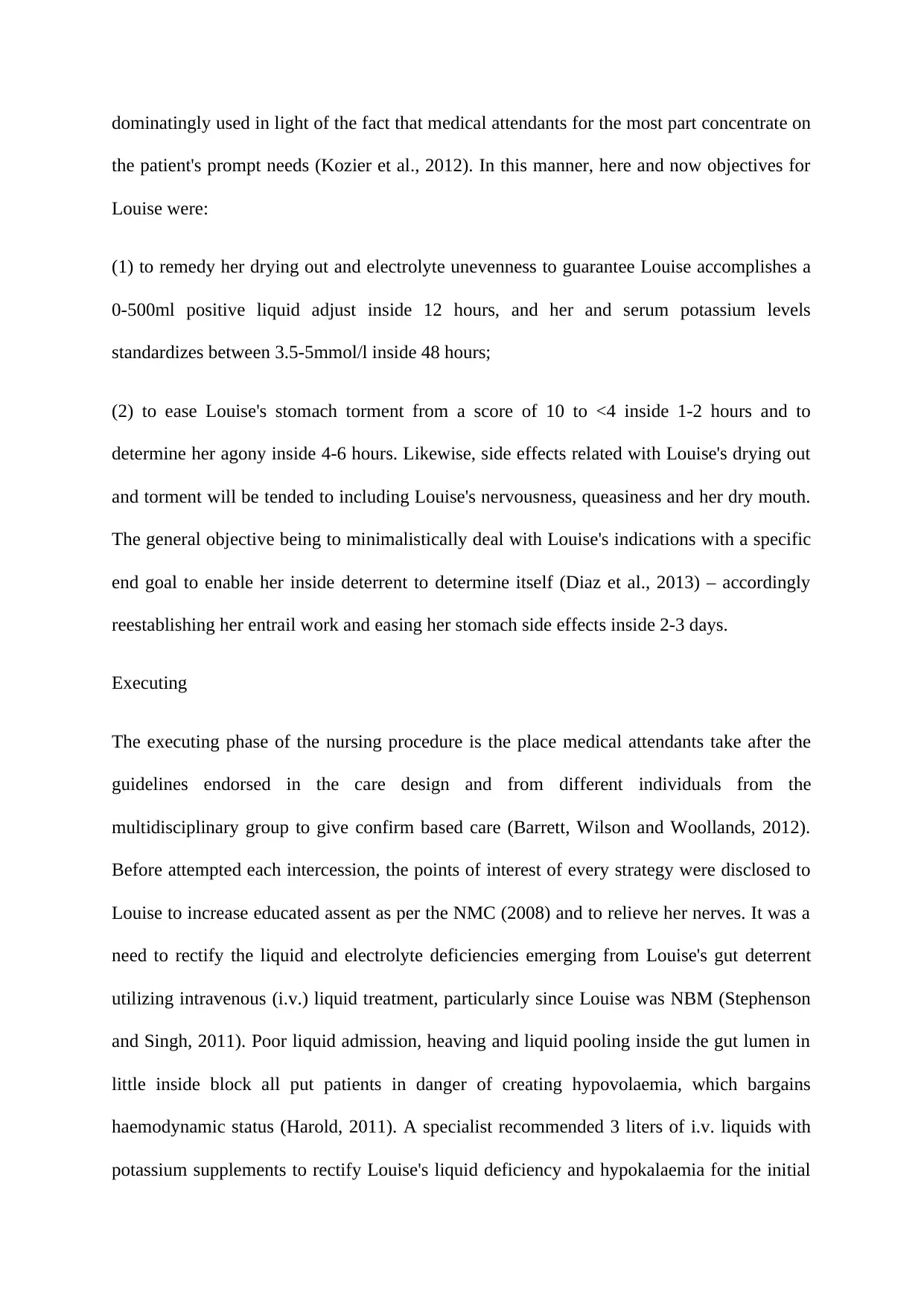
dominatingly used in light of the fact that medical attendants for the most part concentrate on
the patient's prompt needs (Kozier et al., 2012). In this manner, here and now objectives for
Louise were:
(1) to remedy her drying out and electrolyte unevenness to guarantee Louise accomplishes a
0-500ml positive liquid adjust inside 12 hours, and her and serum potassium levels
standardizes between 3.5-5mmol/l inside 48 hours;
(2) to ease Louise's stomach torment from a score of 10 to <4 inside 1-2 hours and to
determine her agony inside 4-6 hours. Likewise, side effects related with Louise's drying out
and torment will be tended to including Louise's nervousness, queasiness and her dry mouth.
The general objective being to minimalistically deal with Louise's indications with a specific
end goal to enable her inside deterrent to determine itself (Diaz et al., 2013) – accordingly
reestablishing her entrail work and easing her stomach side effects inside 2-3 days.
Executing
The executing phase of the nursing procedure is the place medical attendants take after the
guidelines endorsed in the care design and from different individuals from the
multidisciplinary group to give confirm based care (Barrett, Wilson and Woollands, 2012).
Before attempted each intercession, the points of interest of every strategy were disclosed to
Louise to increase educated assent as per the NMC (2008) and to relieve her nerves. It was a
need to rectify the liquid and electrolyte deficiencies emerging from Louise's gut deterrent
utilizing intravenous (i.v.) liquid treatment, particularly since Louise was NBM (Stephenson
and Singh, 2011). Poor liquid admission, heaving and liquid pooling inside the gut lumen in
little inside block all put patients in danger of creating hypovolaemia, which bargains
haemodynamic status (Harold, 2011). A specialist recommended 3 liters of i.v. liquids with
potassium supplements to rectify Louise's liquid deficiency and hypokalaemia for the initial
the patient's prompt needs (Kozier et al., 2012). In this manner, here and now objectives for
Louise were:
(1) to remedy her drying out and electrolyte unevenness to guarantee Louise accomplishes a
0-500ml positive liquid adjust inside 12 hours, and her and serum potassium levels
standardizes between 3.5-5mmol/l inside 48 hours;
(2) to ease Louise's stomach torment from a score of 10 to <4 inside 1-2 hours and to
determine her agony inside 4-6 hours. Likewise, side effects related with Louise's drying out
and torment will be tended to including Louise's nervousness, queasiness and her dry mouth.
The general objective being to minimalistically deal with Louise's indications with a specific
end goal to enable her inside deterrent to determine itself (Diaz et al., 2013) – accordingly
reestablishing her entrail work and easing her stomach side effects inside 2-3 days.
Executing
The executing phase of the nursing procedure is the place medical attendants take after the
guidelines endorsed in the care design and from different individuals from the
multidisciplinary group to give confirm based care (Barrett, Wilson and Woollands, 2012).
Before attempted each intercession, the points of interest of every strategy were disclosed to
Louise to increase educated assent as per the NMC (2008) and to relieve her nerves. It was a
need to rectify the liquid and electrolyte deficiencies emerging from Louise's gut deterrent
utilizing intravenous (i.v.) liquid treatment, particularly since Louise was NBM (Stephenson
and Singh, 2011). Poor liquid admission, heaving and liquid pooling inside the gut lumen in
little inside block all put patients in danger of creating hypovolaemia, which bargains
haemodynamic status (Harold, 2011). A specialist recommended 3 liters of i.v. liquids with
potassium supplements to rectify Louise's liquid deficiency and hypokalaemia for the initial
⊘ This is a preview!⊘
Do you want full access?
Subscribe today to unlock all pages.

Trusted by 1+ million students worldwide
1 out of 41
Related Documents
Your All-in-One AI-Powered Toolkit for Academic Success.
+13062052269
info@desklib.com
Available 24*7 on WhatsApp / Email
![[object Object]](/_next/static/media/star-bottom.7253800d.svg)
Unlock your academic potential
Copyright © 2020–2025 A2Z Services. All Rights Reserved. Developed and managed by ZUCOL.





